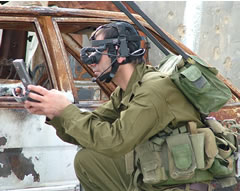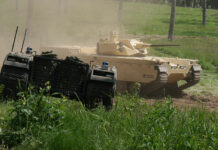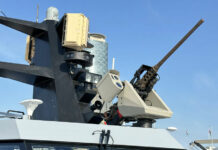 One of the greatest problems facing a successful deployment of an unmanned vehicle is associated with the reliability and survivability of the communication system for video, telemetry and command transmission. Legacy communication systems for UV’s, which relied on analog transmission techniques, are limited by Line-of-Sight (LOS), thus eliminating the possibility of transmitter or receiver to be located behind obstacles, buildings or in urban terrains. Furthermore, the use of the analog video transmission is sensitive in terms of its encryption/scrambling capabilities, allowing an unauthorized receiver to decode the transmitted information. Lightlink datalink communication system, developed by RAFAEL, is optimized to deliver robust performance in areas saturated with interference, clutter and multipath, such as in or over an urban area, forest or jungle. The Lightlink datalink supports the transmission of multiple video sensors over a single RF frequency, and operates in Non-Line-of-Sight (NLOS) environments. The system is designed to co-exist with simultaneous links which operate in the same coverage area. This is achieved via appropriate allocation of time and frequency resources among the multiple links via the C4I network. In addition, the scheme includes certain anti-jam resistance mechanisms that offer robust performance in the presence of hostile electromagnetic interference sources.
One of the greatest problems facing a successful deployment of an unmanned vehicle is associated with the reliability and survivability of the communication system for video, telemetry and command transmission. Legacy communication systems for UV’s, which relied on analog transmission techniques, are limited by Line-of-Sight (LOS), thus eliminating the possibility of transmitter or receiver to be located behind obstacles, buildings or in urban terrains. Furthermore, the use of the analog video transmission is sensitive in terms of its encryption/scrambling capabilities, allowing an unauthorized receiver to decode the transmitted information. Lightlink datalink communication system, developed by RAFAEL, is optimized to deliver robust performance in areas saturated with interference, clutter and multipath, such as in or over an urban area, forest or jungle. The Lightlink datalink supports the transmission of multiple video sensors over a single RF frequency, and operates in Non-Line-of-Sight (NLOS) environments. The system is designed to co-exist with simultaneous links which operate in the same coverage area. This is achieved via appropriate allocation of time and frequency resources among the multiple links via the C4I network. In addition, the scheme includes certain anti-jam resistance mechanisms that offer robust performance in the presence of hostile electromagnetic interference sources.
Lightlink exploits advanced digital video compression and transmission / reception techniques to overcome the clutter and obstacles, transferring video and command data reliably, at compressed, low latency, high rate, high quality video – a critical capability for real-time weapons and reconnaissance applications.
The system uses Coded Orthogonal Frequency Multiplexing (COFDM) modulation with multi-antenna technology which reduces the required fade margin using spatial-temporal processing algorithms and is well suited to support fast moving platforms. The system also provides essential Interoperability between target acquisition and weapon systems (sensor and shooters).
Designed to support lightweight, man portable and small, unmanned systems, Lightlink is designed with small form-factor, is lightweight and has low power consumption. The system has already been deployed in combat during the 2nd Lebanon War, and is employed on RAFAEL’s multiple Aerial, Ground and Surface platforms.
The low-power (1 – 20 watt) system can be implemented in the S, L band or UHF, using bandwidth of 6 – 8 MHz.



















